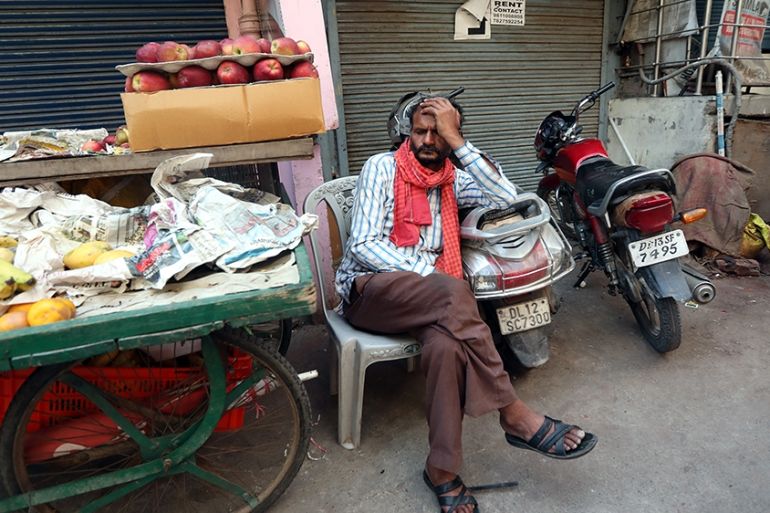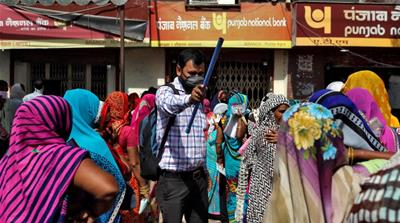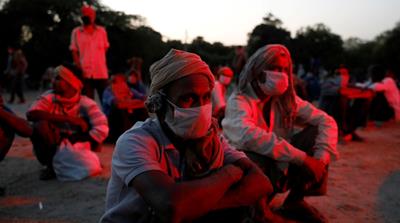World’s biggest virus lockdown saves lives, but hurts businesses
As cases of COVID-19 rise in India and a national lockdown is extended, many businesses wonder how they will manage.

Mumbai, India – On most nights, Arjun Chawla* can be found in one of his three fine-dining Chinese restaurants located in upmarket neighbourhoods of Mumbai, India’s financial capital. But for the past three weeks, he has been forced to swap the noisy chatter of bustling dinner service, for the unsettling quiet of his home.
Like hundreds of millions of people around the world, Chawla is helping to fight the coronavirus pandemic by following the directives of his government to stay home. But in a country of 1.3 billion people, India’s lockdown on all non-essential businesses is proving to be tough for almost everyone.
Keep reading
list of 4 itemsMexico’s teachers seek relief from pandemic-era spike in school robberies
‘A bad chapter’: Tracing the origins of Ecuador’s rise in gang violence
Why is the US economy so resilient?
And while the government has extended some financial help for many of the poorest and relaxed some financial regulations to help the country’s larger firms and banks, small and medium-sized businesses like Chawla’s seem to be falling through the safety net.
“The restaurants are all shut right now, it’s pretty terrible,” Chawla told Al Jazeera. “I’m trying to use the time to experiment on new dishes and have the restaurants deep cleaned. That’s pretty much all I can do.”
But Chawla recognises that he is one of the lucky ones. Unlike most of India’s restaurant and food services industry, estimated by consultancy firm Care Ratings to be worth about $50bn, he owns the buildings that house his restaurants. That means rent – a potentially sizable overhead – is not a concern. But he is continuing to pay his staff of about 200 people on time, and doing so is starting to weigh heavily.
“They depend on me and it’s a priority,” he said, “but it’s a lot of pressure when you have no sense of when things will be normal again.”
The lockdown, in place since March 25 and extended last week until May 3, has led to a sudden halt in demand, and a near-total lack of revenue for many firms even while they continue to pay rents, wages and interest payments. Analysts say the pain for business owners looks set to continue.

The retail sector, largely reliant on consumer confidence and the public being able to leave their homes, is being particularly badly hit. According to management consultants KPMG, it contributes approximately 10 percent of India’s gross domestic product (GDP), the sum value of all the goods and services produced in a country over a given period, and employs approximately 8 percent of the workforce.
India’s aviation and tourism industries, which together contribute nearly 12 percent of GDP is staring at job losses totalling 38 million or 70 percent of their total workforce, says KPMG.
But India’s small and medium-sized enterprises (SMEs) could be hit disproportionately harder than others.
They generate about 30 percent of the country’s economic activity and support 111 million jobs, according to government estimates. Fears are mounting that many such firms could fold under the pressure of an extended lockdown and take much-needed jobs with them. And while many countries have offered financial support to help withstand the shock, including help with wage bills, the central government is yet to offer any direct support to companies.
“The quickly imposed travel ban and then a lockdown was a step in the right direction to contain the outbreak given we still aren’t testing enough,” Priyanka Kishore, head of India and South East Asia at Oxford Economics, a consultancy firm, told Al Jazeera. “But an economic package has not come close on the heels of that,” Kishore said.
“Clearly, given how much activity has come to a standstill, there is more to be done,” she added.
Testing times
India’s lockdown has been ranked as one of the strictest globally, according to a COVID-19 government response tracker by the University of Oxford. While it may have saved lives, it has also hurt an already fragile economy.
Slightly less than half of the country’s districts have so far reported virus cases, but an indiscriminate curfew has meant the country is losing an estimated $4.6bn a day, according to Mumbai-based Acuite Ratings & Research Limited. It is a high price for a country that was already on a six-year declining growth trajectory and struggling to employ a workforce growing by an estimated five million people a year.
“Even when the lockdown is progressively brought down and sections of the economy start to function again, demand for these sectors will revive quite slowly,” Suman Chowdhury, chief analytical officer at Acuite told Al Jazeera, referring to retail sectors like tourism, entertainment and travel. “We should expect severe disruption for at least another six months, seriously impacting their performance for the current fiscal year.”

While small and medium-sized businesses may struggle the most in the short term, larger organisations will not be immune to the sudden halt in demand. Even before the measures were implemented, many companies were struggling to raise enough capital to expand, a credit crunch made worse by the recent default of major non-bank lender IL&FS in late 2018.
The shock of the lockdown has caught many wrong-footed, Oxford Economics’ Kishore said. “We’re probably going to see balance sheet stresses worsen and in important sectors too, like infrastructure, which have a high multiplier effect on the economy,” she said, referring to her forecast that a slowdown in the rollout of large public construction projects would have a knock-on effect on other areas like cement and steel production, with a resulting loss of many jobs.
More than half of all CEOs surveyed expect job losses post lockdown, according to a Confederation of Indian Industry poll conducted in early April. Indian media houses appear to have been hit first, with the National Union of Journalists expressing concern over “the suspension of publications, salary cuts and summery [sic] dismissals of working journalists in the wake of COVID-19 pandemic”.
Supporting business
New Delhi has announced various relief measures in the wake of the pandemic, but they have so far been targeted at welfare payments for low-income groups. The government has also loosened regulatory measures for larger firms, such as giving companies facing bankruptcy procedures more time to reach a resolution with creditors.
The Reserve Bank of India’s (RBI) three-month loan moratorium has been welcomed, but some also warn it could end up merely delaying rather than solving problems. “Three months down the line, businesses will still have to pay back higher amounts to the banks – and there’s no indication that they will be in a better position to do that,” says restaurant owner Chawla. “It would be better if they had made this moratorium interest free.”
Industry bodies such as the Confederation of Indian Industry (CII) have also called on the government to ease the tax compliance burden on small companies and extend timelines for electricity bills and other duties, as a way of alleviating pressure on their expenses.
Amid a dearth of working capital, banks will need to step up their lending to help many businesses stay afloat, says Bidisha Ganguly, chief economist at the CII.
But doing so could put extra stress on the financial system, which has faced several sources of instability recently.
“Right now, India’s banks are well capitalised, but we wouldn’t want them to go back to a cycle of non-performing loans,” Ganguly told Al Jazeera. “That is why we are asking the government to work with the RBI to provide a capital buffer.”
But with tax collection taking a hit and the Financial Responsibility and Budget Management Act preventing the government’s fiscal deficit limit from being breached, India’s monetary firepower remains diminished.
“They will not want to risk a major downgrade in sovereign rating,” says Karan Mehrishi, lead economist at Acuite. “It is unlikely we will see any aggressive stimulus that would mean throwing fiscal prudence completely out of the window,” he told Al Jazeera.
Getting back to business
While the lockdown remains in place, the government is allowing some less-affected areas to ease restrictions after April 20 if local authorities can show that virus cases are not prevalent. This should help commercial activity to restart, particularly in rural areas and relieve the plight of daily wage earners, in particular, said Prime Minister Narendra Modi in a recent television address.
“The outbreak is not uniform in nature, so more control at the local level would be helpful,” says Acuite’s Chowdhury. “They could start with the ramp-up of production of basic and intermediate goods like steel, cement, and chemicals which are already operating at around 25-30 percent capacity.”
But the worst may be yet to come for India’s economy.
An exodus of migrant workers from the cities back to their native villages in recent weeks could hamper a rapid return to normality, especially for labour-intensive sectors like construction, while possibly spreading the virus even further.
“We’re working with state governments to make sure they can organise transportation, provide masks and ensure all workplaces have been sanitised,” says the CII’s Ganguly. “This will be key to a safe recovery”.
Simply reopening factories and businesses alone, will not be enough to fix the economy’s woes, she warns. “We will also need to think about stimulating demand for these products, which will currently be very low given that many people have lost livelihoods and wages,” said Ganguly.
*Name changed on request